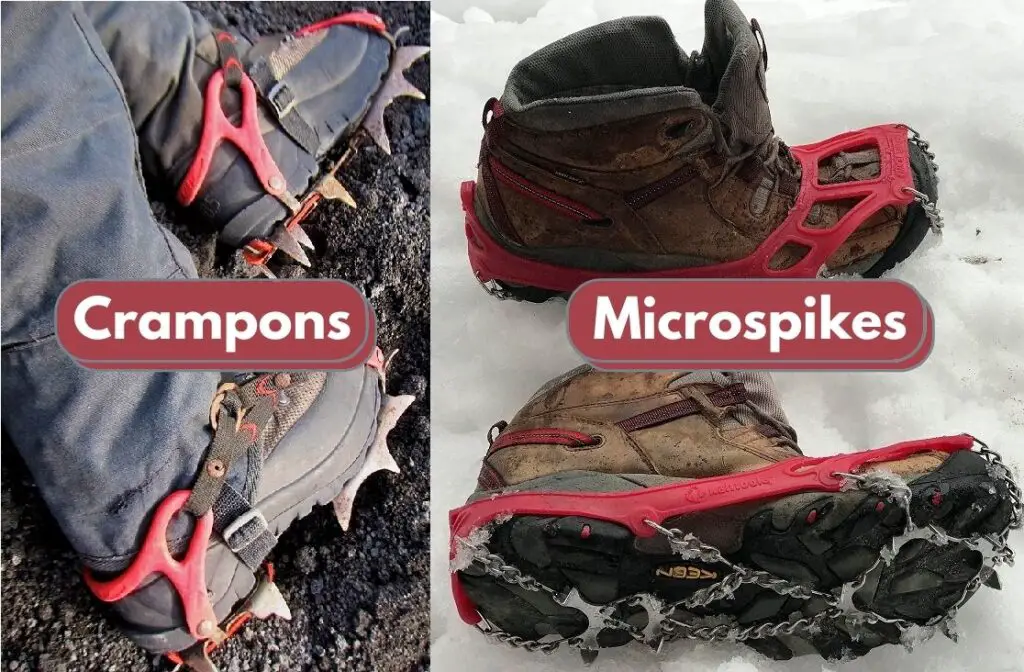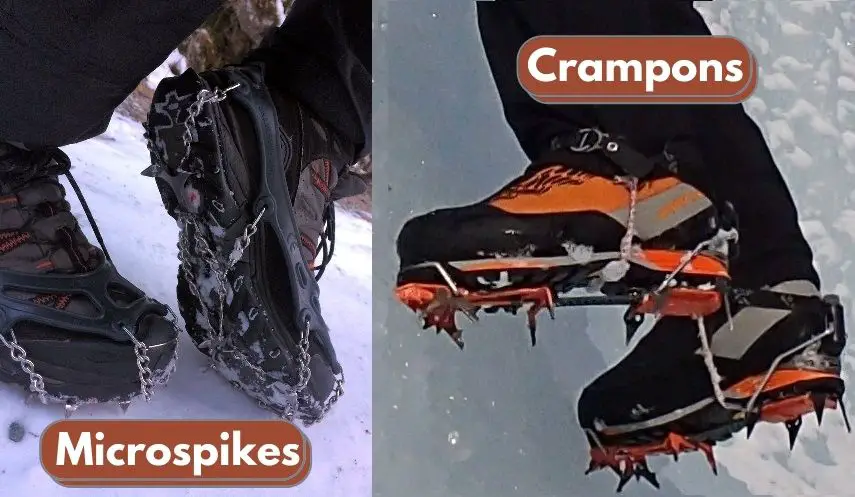If you’re a winter hiker, then you know that there are times when you’ll need to use decide between crampons vs microspikes.
But what are the differences between them? And when should you use each one? In this blog post, we’ll compare microspikes vs crampons and explain when it’s best to use each one.
So what’s the difference between crampons vs microspikes? Crampons have deep spikes for climbing hard ice, while microspikes are better for walking on hard-packed snow and flat terrain.
There are a few additional considerations when choosing between microspikes versus crampons, which we’ll cover in greater detail in today’s guide.
Crampons Versus Microspikes: 5 Key Differences

Before you decide between crampons and microspikes for your next cold-weather adventure, let’s cover some of the biggest differences in each.
Intended Use
Microspikes are intended to be used on ice or hard-packed snow when the terrain is mostly flat, and can be taken on or off to adapt to the changes in your hike.
Microspikes are great for trekking, but not climbing. They’re also better than crampons for use on mixed terrain that has rock.
Crampons are designed for climbing ice or for use on hard ice and are more commonly used when climbing high slopes and mountaineering purposes.
Crampons are not intended to be used for trekking, only climbing.
Design
Microspikes are kind of like snow chains for your shoes. They are sets of chains that attach around your hiking footwear with 1/4″-1/2″ spikes on them to aid you in additional grip for slippery conditions.
Crampons are frames that fit around your footwear that have large spikes on the bottom, usually 1″-2″ long.
Material
Microspikes are traditionally made of welded stainless steel chains that provide flexibility, and heat-treated stainless steel spikes that are durable and corrosion-resistant.
Crampons are usually made of steel or aluminum, and which crampon material you choose is based on the type of terrain you’re climbing.
Price
Pricing is a very clear difference when comparing microspikes vs crampons.
Microspikes are much more affordable than crampons, with microspikes running around $50-$75 per pair, while crampons can run from $180-$400 per pair.
Maintenance
Caring for crampons vs microspikes is pretty simple, with both requiring 4-6 hours of drying time in a warm place after use and occasionally oiling them with machine oil to keep the joints and moving parts working smoothly.
The main difference is that crampons will need their spikes sharpened after every 100 miles or so to keep their performance up.
You can sharpen the crampon spikes yourself or take them to an outdoor store near you to have it done.
Why You Need Crampons (Or Microspikes)
Walking or climbing on ice or hard-packed snow is extremely challenging, and going unprepared can pose serious safety hazards.
Crampons and microspikes help you get better grip and traction on icy terrain.
Not only will they help you easily climb or trek slippery surfaces, but they also help increase the total surface area of your hiking footwear, cutting down on how far you sink in the snow with each step and help you spend less energy.
Hiking Crampons Vs Microspikes: Which Should I Use?

Now that we’ve gone over the key differences of each, let’s compare microspikes and crampons in different situations to help you decide which is best for your needs.
Shallower Slopes: Microspikes
If you’re hiking on a shallower slope that isn’t too icy, then microspikes will give you the best traction.
You don’t need the deep spikes of crampons for this type of terrain, and microspikes are easier to take on and off as conditions change.
Steeper Slopes: Crampons
For steeper slopes that are more icy, then you’ll want to use crampons. The deeper spikes will give you better grip on the ice, and they’re more durable for rougher terrain.
Mixed Terrain: Microspikes
If you’re hiking on a mix of surfaces that includes hard-packed snow, ice, and rock, then microspikes are the better option. They provide more grip than crampons on snow and better stability on rocky ground.
Microspikes Vs Crampons: Wrapping Things Up
In conclusion, it’s important to know when to use crampons vs microspikes when hiking in cold weather conditions.
Crampons should be used for climbing icy slopes or mountaineering purposes, while microspikes are great for trekking over hard-packed snow or flat terrain.
With the right gear, you can safely enjoy your hike no matter what treacherous conditions lie ahead!
Check out our other great hiking guides while you’re here:
- Our hiking guide to Mount Of The Holy Cross
- Teva Vs Chaco sandals for hiking
- Hiking Precipice Trail in Acadia National Park

